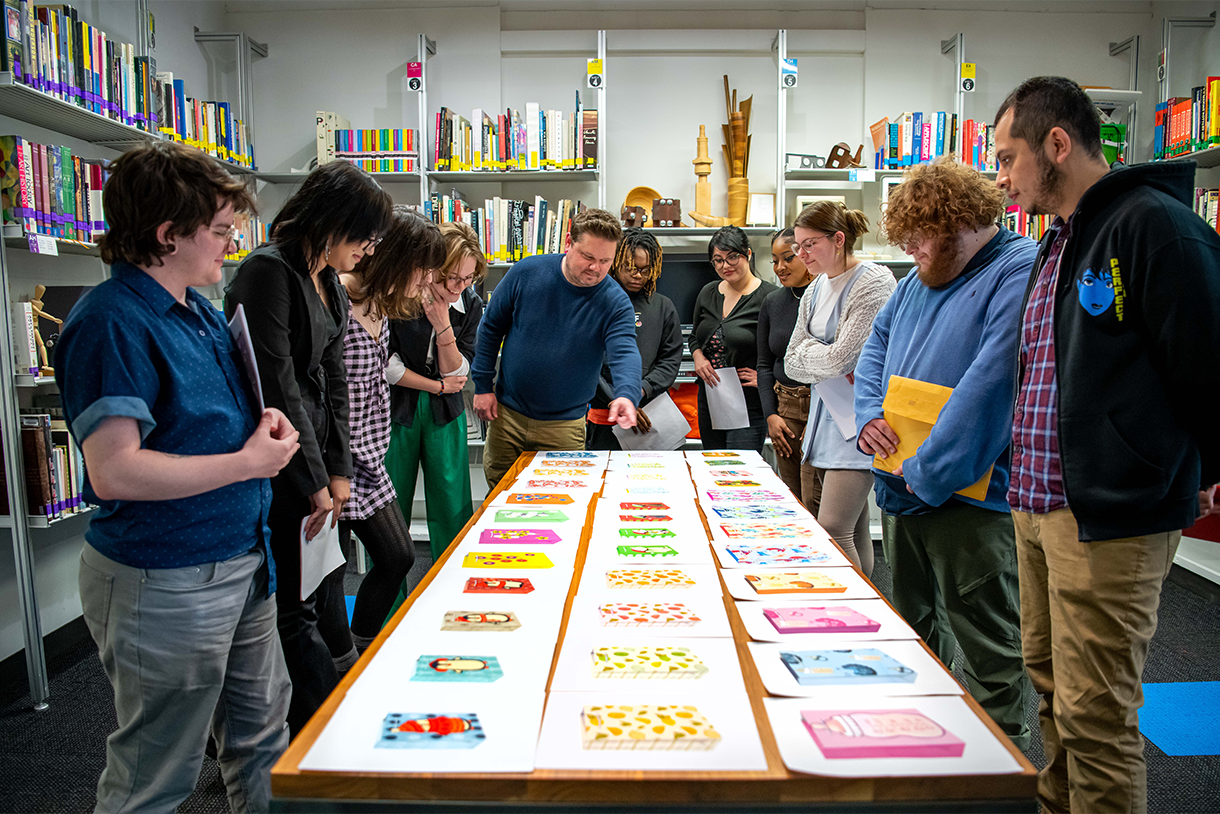Corporate Collaboration Presents Students Opportunity to Bring Gift Bag Designs to Market
Students gather around a table with Associate Professor Christopher Arnold as they evaluate designs for a collection of baby-themed gift bags created by Chase Williams, then a senior at Columbia College Chicago.
“Should the baby bottle have measurement lines on it?” asks one student. “Or is that too busy?”
A lively discussion follows with the Design students offering Williams suggestions, addressing everything from the number of lines on the bottle illustration to the colors used on the bags. As Williams determines what tweaks he will and won’t make, a deadline looms over the classroom. They all must submit their gift bag designs to their client in less than 48 hours.
“Working with real clients, it’s a new experience,” says Blake Olsen, who is now a rising Senior.
A new experience, but also an impactful one for students who took Arnold’s Special Issues in Illustration/Special Topics in Design class Spring semester. And the experience was all possible thanks to a partnership Columbia has with the marketing firm Madak and the Mexico-based gift bag seller Dipak.
“Collaborations are one of the best ways to bring the career to the classroom,” says Arnold, an associate professor of Illustration.
Goal-Oriented Mindsets Drive Project
The students’ goal with this collaboration: To design sellable gift bags with Madak’s guidance. Dipak, Madak’s client, will pitch select designs to stores such as Dollar Tree and Walmart as well as sell the bags on Amazon. If selected by Madak and Dipak, collections designed by the spring semester students will be shown to buyers in the fall.
The companies participating in the project also have objectives in mind, says Jordan Carlson, who was a Senior Marketing Strategist at Madak at the time of the class.
For Dipak, the collaboration presents the opportunity to become more knowledgeable of American design styles and trends. And for Madak, the experience of working with the class helps them support their client – Dipak. It also creates an avenue for recruiting interns, with Madak asking for, and getting, intern applications from many of the class’s students and eventually choosing Madolyn Miller, a rising-Senior transfer student, to work at Madak this summer.
Give-and-take critiques and performance-under-pressure are just two elements of the class.
“The experience encourages students to first explore the process of bringing an idea to market and then examine the impact their product has in the consumer landscape,” Arnold says. “It’s a dynamic set of experiences where the students recognize through the collaborations that they are ready for more than the classroom.”
Learning the Art of Presenting and Embracing Feedback
This feedback session featuring the baby bottle discussion was the last chance for students to hear from their peers and Arnold before sending more than 240 gift bag designs to the professional designers and marketing pros at Madak for feedback. The classroom critiques proved valuable to students and their work.
“I think everybody's really good at critiquing each other and nobody takes it personally,” Miller says.
The team at Madak then assessed each design and assigned probability scores — numbers from 1 to 10, with 10 indicating a high likelihood that Dipak would choose their design and pitch it to buyers. The bags were presented as collections of four and focused on these themes: Birthdays, Christmas, babies, and all occasions.
Once all submissions were made, students officially presented their designs to Madak via Zoom, explaining what informed their design choices.
“When I worked at Party City, farm animals were extremely popular,” Miller explained as she discussed her choice of cows in one of her designs. Her own collection of stuffed animals, she told the Madak team, inspired another collection.
Madak’s Art Director Ron Pura provided feedback after each student’s presentation, focusing on what his team thought would work for Dipak and what wouldn’t. Saturated colors and penguins in sweaters, great. Muted colors and complex designs, not so much.
“It's not as scary as I thought it would be,” says Olsen. “Being in a class like this and having guidance from other students and from a professor, it's making it a lot less scary to talk to someone who's been in the industry for a while and talking to professionals.”
Experience Offers Important Takeaways
Arnold thought that the freshness of the students’ design choices impressed, and apparently it did.
“I took away a wealth of inspiration from the younger generation of students and their gift bag designs,” Jordan says.
She hopes that, in turn, the project gave the students some real-world experience with a company that has products on store shelves throughout the United States and gave them the challenge to produce original work with constraints from an actual business.
By all accounts, this challenging real-world exercise did truly resonate with students, who look forward to seeing if their designs are selected in the fall.
“I think it's good practice and it's nice to be able to work with a professional client,” Miller says.
That said, she appreciated having her professor there to guide the process. “It was also nice to have a middleman with our professor to kind of ease into it.”


